Concepts and solutions to parallel Windmill converter up to 6 MW
Norbert Pluschke, SEMIKRON (Hong Kong) Co., Ltd., Hong Kong
Abstract
The power requirement for windmill converter is getting higher and higher. Some years ago most of the companies developed 1.5 MW-DFIG (doubly fed induction generator) windmill converters which requested only a converter power of 500 – 700kW. Today many companies are developing windmill converter in the power range of 3MW and higher. The future trend is going to be in full size windmills and the requested converter power is much higher compared to DFIG converter.
The periodical question “is it better to connect IGBT modules in parallel or is it better to connect complete converter in parallel with independent controller”? Another alternative is to connect converter stacks in parallel with only “one controller” or use independent converter with 1.5MW and connect this to a multi pole generator.
In our paper, we will compare several solutions to design windmill converter in the power range of 1.5MW to 6MW. We will compare power modules in parallel, power stacks in parallel and complete independent converter in parallel.
A comparison of Full Size Windmill topologies from then point of converter design will be presented.
Furthermore we will introduce solutions to design high power windmill converter up to 6 MW. We will consider power density factor, life time of IGBTs, number of capacitors for line side and generator side converter and cooling concept in the high power converter design.
Protection systems are required if we connect power modules or converter in parallel.An introduction of several solutions will be introduced. Modularity is the focus in our paper. We will introduce a solution which can fulfill a modular windmill converter design in the power range between 1MW to 6MW. Redundancy is another aspect which we consider. The modular converter design is a perfect solution to guarantee a reliable operation.
Key words: Paralleling of converter, SKiiP technology, safety concepts
1. Windmill topologies
The most famous windmill topologies in the market are DFIG and Full Size. See Fig. 1 below.

Doubly-Fed Induction Generator (DFIG)-based wind turbines employ a wound rotor induction generator with slip rings to take current into or out of the rotor. This topology is still dominating the Chinese market.
The market share for full scale windmill turbine is growing year by year. High power converters are necessary to serve this market. Fig. 1 shows that high power converter must be modular and independent of the required power range. A power converter between 1.5MW – 2MW is the best size to design windmill converter from 3MW up to 8MW.
2. IGBT Power modules
Today, there are many IGBT suppliers designed IGBT module for high power windmill application. IGBT modules with different blocking voltages and currents are in the market. Blocking voltage from 1200V up to 6.5KV is available with a current rating between 1000A up to 3600A.
Semikron will focus on 1700V IGBTs. All higher blocking voltage IGBTs are not suitable for a compact windmill converter design with high efficiency in the power range between 3MW to 6MW.
The Vce and the switching losses of 3300V or 6500V IGBTs are too high when compared to 1700V IGBTs. Furthermore, our focus is on the baseless IGBT modules (SKiiP technology) to improve the thermal resistance and the lifetime of the IGBT module. Semikron considers the lifetime of the capacitor in their solution. The trend goes towards the polypropylene capacitors with a DC voltage of 1300V.
3. SKiiP in parallel for high power converter
Connecting SKiiP modules in parallel is possible and is recommended for up to 2MW.Semikron provides a parallel board. This parallel board can handle paralleled SKiiP modules (up to 4 SKiiP in parallel is possible) just like as “one SKiiP module”. Hence,the customer only have to manage “one SKiiP module”. The flexibility in the SKiiP module allows a wide power range under the consideration of keeping the same power unit design. SKiiP4 is available as 3-fold (1800A), 4-fold (2400A) and 6-fold (3600A).
The mechanical design is similar and only the number of folds are different because it is to provide a low stray inductance for the DC bus design. See Fig. 2 below.

4. Windmill converter in parallel
There are different aspects to be considered in the development of high power windmill converter. The location of the converter is very important for the design. Offshore converter has different requirements compared to onshore converter. Redundancy must be considered for offshore applications.
Several topics are important for the paralleling of converters:
a. which passive coupling network on power site;
b. which topology and operating strategy of controller for paralleling;
c. special generator with separate windings
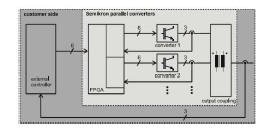
Fig. 3: FPGA board with current controller for a symmetrical current sharing
The FPGA board is using the current signals from the SKiiP-IGBT-module. The FPGA board has its own micro controller and is able to manage the current balance between the parallel converters independent of the main controller board. The controller board is on head of this FPGA board and is responsible for the whole control system. The most important is the combination of SKiiP with current sensor and FPGA board. Additional current sensor for the current loop can be installed in the wire to the windmill generator.
5. Output inductance
If we have to connect converter in parallel we must consider the circulating current between the paralleled converter. Standard reactors are very common but sometime too big and too heavy. We like to introduce a new inductance which can adapt automatic on the load situation. It will avoid imbalanced current during the turn on process. See Fig. 4 below.

Fig. 4: Common mode choke to balance unsymmetrical phase current (5-10uH)
This inductance can be installed very easily in every cabinet and will improve the current balance between the parallel converters. Additional single inductance can be installed as well. Values between 20-40uH are very common.
6. Windings of the windmill generator
Most of the windmill generators above 1.5MW are not designed in single winding topology. Several windings are available and can be connected to the converter. 3MW windmills usually use 2 windings with 1.5MW. This is a perfect solution to connect 1.5MW converter in parallel. Every winding will get one converter. Higher power like generator with 8 MW have 4 windings with 2MW. Semikron can provide a compact 2MW converter without paralleling of IGBTs. Semikron’s new SKiiP4 IGBT module has a current of 3600A by 1700V. It is the perfect solution for 2MW full size converter. Refer to Fig. 2.
7. Compact converter in parallel
Offshore windmill is getting more popular and the power is rising. 3MW windmill are very common for offshore application. A very important requirement many windmill customers is the weight of the converter. Standard converter for 1.5MW or 2 MW is tooheavy and difficult to handle. Standard 2 MW windmill converter have a weight of 150kg – 160kg. Furthermore, these converters are designed as a 3-phase power unit and not as a half-bridge power unit.
Semikron introduced a new modular converter family under the name “SKiiPRACK”.SKiiPRACK is a modular cell design which can be configured according to the demandof the customer. The customer can install and reinstall cell by cell and the weight of one cell is below 50kg. In critical situations, the customer can split the cell into two blocks ¾IGBT block and capacitor block. The weight of one block is below 25 kg and easy to handle by one person. See Fig. 5 below.
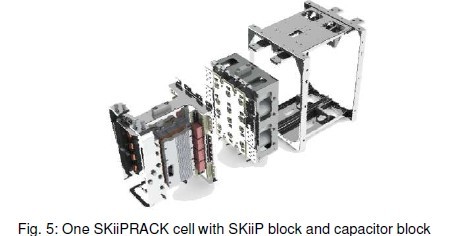
The free configuration of the SKiiPRACK is the key point of this new stack design.Semikron can design the SKiiPRACK according to the customer specification for DFIG converter with and without brake chopper. It is easy to connect cell by cell in a cabinet. Fig. 6 shows different SKiiPRACK combination and the flexibility of this system.Standard converters which are always connected in a 3-phase system are “snow from yesterday” and not state-of-the-art anymore.
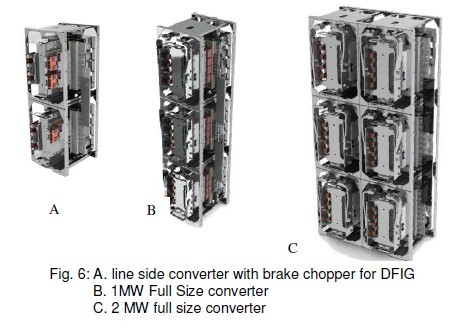
The latest development of Semikron is a new 2MW SKiiPRACK windmill converter with the strongest IGBT module in the market. A SKiiP-3600A-IGBT module is the heart of this new design. See Fig. 7. The concept is exactly the same as what we introduced before. Also this cell can be disassembled in 2 blocks¾IGBT block and capacitor block and the weight per block is below 25 kg.
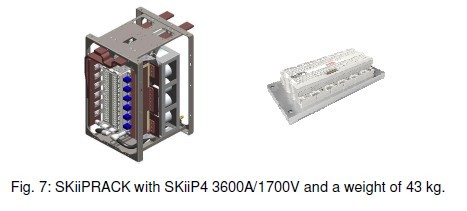
This SKiiPRACK is the basic unit for the design of windmill converter up to 8MW. 3 power units in parallel can generate 6MW (2MW per unit). Refer to Fig. 8.
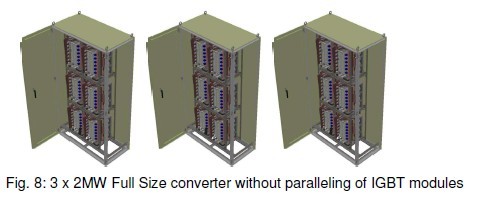
In the SKiiPRACK design, Semikron considered the connection of the water cooling hose. Leakproof hose connectors are installed. Furthermore is the access for all screws from the front side for assembly and disassemble. A low stray inductance DC bus designed to connect all cells is also considered.
The design of 8MW windmill converter is no longer a mystery with this flexible SKiiP-cell construction. Fig. 9 shows the design of an 8MW windmill turbine.
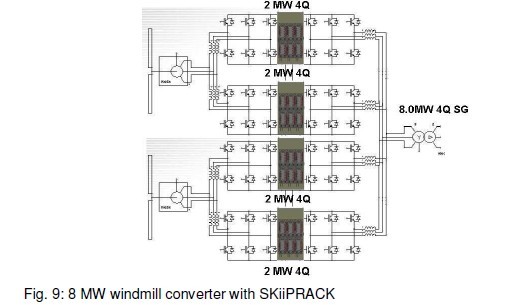
Fig. 9: 8 MW windmill converter with SKiiPRACK
8. Summary
Semikron introduced a new power unit construction which is very flexible in design and configuration. The power density is above 18kW per liter. Standard stacks with standard IGBT modules with base plate cannot reach this power density.
Windmill converter based on a 2MW unit can reach 8 MW in paralleling operation. The portable weight of the stack is another big advantage. Standard stacks are too heavy that the user has to install special handling tools to install or reinstall these stacks.SKiiPRACK is the most suitable stack for renewable energy application.
Literature:
[1] Backhaus, K.: Intelligent power module family SKiiPPACK 3rd generation, PCIM Europe, 2000
[2] Pluschke, N. : Converter topologies for offshore windmills,’ Offshore Wind China 2009 conference
[3] Pluschke, N. : High power density design for windmill application – CWP 2009, China
[4] Prof. Schumacher, TU Braunschweig,; Concepts for Converter in parallel
[5] SEMIKRON; SKiiPRACK application note.